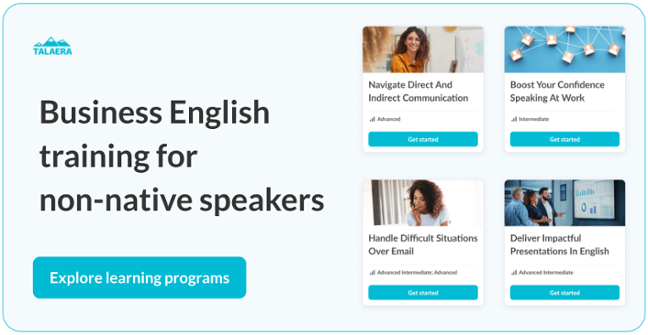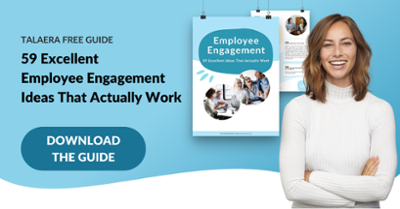By Paola Pascual on Aug 9, 2021 9:17:02 AM
Your employees give their best each day. They are committed to your organization’s goals and values. They are eager and motivated to contribute to the company’s success. They get up in the morning and think “Great, I’m going to work.” They feel good about what they do. Sounds ideal, right? This is what employee engagement looks like. In a fast-paced working environment, working remotely, with increased work pressure and uncertainty, many managers and business owners are struggling to keep their employees engaged. But there’s good news - it’s not an illusion, it is possible.
What is employee engagement?
Workplace engagement is an emotional state where employees feel emotionally attached to their company and role. Engaged employees care about their work and they feel passionate, energetic, and committed. An engaged workforce goes the extra mile, not just for the sake of getting promoted, but because they feel invested in the company’s goals.
Are employee engagement and employee happiness the same?
A happy employee is not necessarily an engaged employee. They might be happy but that doesn’t mean they are working hard. Similarly, employee engagement is also not the same as employee satisfaction. A satisfied employee might do their usual 9-5 and be okay with it, but they will not make a discretionary effort when there’s a need for it.
Although these terms may have the same outcome – a happy and productive workplace– they differ. GetHppy describes it as “two halves of the same apple.” This means that the two concepts are interlinked and interdependent. It is not an easy task to precisely describe what these concepts mean, but here's an attempt:
- Employee happiness is what we feel at work. It is a mindset, an intrinsic state, in which you feel positive about the work you do. You feel like improving, you feel like solving problems, and you feel fortunate about your situation. Experts often treat happiness as psychological well-being, which encompasses life satisfaction, the presence of positive emotional experiences, and the absence of negative ones. Of course, happy employees sometimes experience strong negative emotions, but the final outcome and how they decide to deal with them is overall positive.
- Employee satisfaction is what we think about work. Satisfaction is the result of having our wishes fulfilled. It is more based on reason and on receiving, while happiness comes from the heart or feelings and it’s more based on giving. Satisfaction is easier to predict (if X happens, then employees will feel satisfied), and it is often dependent on others. Happiness, on the other hand, will look different in different scenarios, and it depends on each individual.
- Employee engagement is how driven we are and how much we care. Work engagement is about being passionate at work and feeling that we can make an impact on the company’s success. Satisfied employees may be content with their job conditions (e.g. compensation, perks, work-life balance), but they are not necessarily engaged – if they are not engaged, they will show up to work but will probably not break a sweat.
Why is employee engagement important?
“The way your employees feel is the way your customers will feel. And if your employees don’t feel valued, neither will your customers.” –Sybil F. Stershic, Taking Care of the People Who Matter Most: A Guide to Employee-Customer Care
Effective employee engagement in the workplace is a win-win for everyone involved –employers, customers, and employees themselves. Here are some of the benefits of employee engagement:
- Greater profitability. Engaged companies have 6% higher profit margins than unengaged ones and receive 21% greater profitability.
- Better customer service. When your employees are engaged and care about their jobs, they also care about your customers.
- Higher shareholder returns. Engaged employees are more productive and usually provide better service, which results in more satisfied customers. If your customers are happy, it translates into increased sales and higher levels of profit, which will, in turn, bring about higher shareholder returns (Kenexa observed that engaged organizations provide five times higher shareholder returns over five years).
- Higher employee retention. A 2009 meta-analysis on engagement by a UK Engage for Success study found that high levels of employee engagement are associated with lower employee turnover (up to 59% less turnover).
- Increased productivity. Research shows that engaged employees are 17% more productive than their counterparts.
- Lower absenteeism. Highly engaged workplaces experience up to 41% lower absenteeism.
- Greater employee loyalty. Employees are less likely to leave if they care about the success of the organization and they feel nicely challenged and appreciated.
What are some employee engagement challenges?
Workforce engagement is a tremendous asset to an organization but 85% of global employees are either not engaged or are actively disengaged at work. The reasons for such a high percentage might be the following challenges:
- Employee engagement is not a priority. Some senior leaders struggle to tie workplace culture and employee engagement directly to their business goals. This leads to poor engagement strategies and insufficient funding for those activities.
- Communication is ineffective. Language barriers in the workplace can be one of the greatest barriers to employee engagement. If employees cannot communicate confidently with their coworkers or their managers, their productivity and engagement will drop. Here’s how to overcome the top 4 communication challenges in the workplace.
- Leaders are not aligned. Managers play a crucial role when it comes to keeping employees engaged. They need to actively engage them both at an individual and at a group level, and inspirational communication and greater transparency are two simple immediate strategies that will contribute to higher engagement.
Want to increase employee engagement among remote workers? Consider this“
“Employee engagement is the art and science of engaging people in authentic and recognized connections to strategy, roles, performance, organization, community, relationship, customers, development, energy, and happiness to leverage, sustain, and transform work into results.” - David Zinger, Let’s Co-Create an Employee Engagement Charter, The Employee Engagement Network
If you want to ensure employee engagement in the workplace, you will first need to understand what engagement looks like in your organization. It is always interesting to see how other companies are doing it (here are 4 employee engagement examples from successful companies) and brainstorm what could work for you, based on the budget available, the number of employees, the work methodologies, etc.
Important! Remember that you cannot achieve employee engagement by manipulating your employees’ emotions. For example, by calling your team “a family”, you may be setting misleading expectations (a family is a family no matter what, while employees come and go). The “we’re a family” manipulation includes hip job titles (e.g. “ninja,” “guru,” or “customer happiness”) and using inclusive names for low-level employees (e.g. “partners” for baristas at Starbucks or “associates” for Walmart employees), among others. Although some of these initiatives may be genuine, if this is just a trick to make them more invested, your workforce will see through it very quickly, having the opposite of the desired effect. If you’re curious about what other types of corporate lies you might be unwillingly telling your employees, check out these other examples.
What predicts employee engagement?
Drawing from numerous studies and experts’ opinions, we have grouped the main predictors of employee engagement into the following four categories:
#1 Work
Employee engagement starts with the specific work of the individual. First, they need to have role clarity. This means that employees have a clear understanding of their tasks and responsibilities at work. They also need to have adequate tools at their disposal, and companies are the ones who should provide the necessary resources (materials and equipment) for employees to do their work right.
Whenever possible, encourage task variety throughout their workday. Having a nice range of tasks that require different skills throughout their workdays may also help employees stay engaged. And last but not least, employees need to find meaningfulness in what they do at work. It is your organization’s responsibility to create a sense of purpose. Individuals are more engaged if they can see the impact of their work in the organization. Help them see the connection between their individual work and your company’s broader mission.
One way to reinforce your organizational values is to build out a Confluence page for each of your company values online with resources. Chloe Sesta, Global Director, Inclusion & Experience at Deputy, says “one of our values is ‘listen to learn’, so we are adding lots of resources [to the Confluence page] around active listening, giving, and responding to feedback, etc.” You can start small and build it over time. It will help your people get more familiar with the concepts in a more practical way!
#2 Learning & Development
Employees with a growth mindset tend to be more engaged at work, and learning drives engagement. A study by Udemy found that 80% of employees feel that learning new skills would make them more engaged, and lack of opportunity to learn new skills is the main reason why employees feel bored at work (46%). Listen to what your employees would like to learn and offer different learning opportunities and corporate training options.
Mentoring is also a great way of developing talent within your company, and it draws from individuals’ eagerness to contribute to the organization’s success. Offering a two-way learning opportunity through coaching and/or mentorship will help your employees feel valued and keep them engaged.
Career opportunities matter. Create formal career development plans. Structure your organization in a way that supports employees and allows them to grow while individuals are also able to make their own decisions.
An interesting idea is to offer a development day where your employees can work on helpful mindfulness techniques – check out Wholly Mundane by our teacher Virginia. Read other excellent employee engagement ideas in our free guide.
#3 Leadership support
Your leaders are one of the most powerful tools to engage employees. In fact, poor management is one of the main reasons employees quit their jobs. Choose your leaders carefully, and give them special attention, as they are the direct link to your employees.
A leader that boosts engagement leads by example. They are accessible and ask their employees how they want to be managed. They learn to set boundaries, don’t micromanage, and offer support through one-on-one meetings. They know how to communicate effectively, they can give and receive feedback effectively, and they are the voice of their team members. Effective leaders focus on the positives and, above all, are inspiring. And to make sure that leaders have all those necessary skills, organizations often offer leadership and communications training.
#4 Positive Culture
Your company culture has a strong impact on how your employees feel at work and on their motivation to go the extra mile. Cultivate a positive culture through strong communication, diversity & inclusion policies, and work-life balance opportunities.
When it comes to communication, transparency is key in today’s workplace. Help your employees understand the what, why, where, when, and how. Open communication will help you foster employee happiness, makes compliance easier, improve relationships with customers, and grow more engaged employees. Flowtrace is an app that helps you break down communication barriers and information silos. If the problem comes from not feeling comfortable speaking English at work as a second language, check out Talaera’s training programs.
You can also implement a ‘User Guide’ where each employee defines expectations and boundaries around communication. This includes answers to ‘How do I value communication to happen?’ ‘How do I provide feedback?’ ‘How do I prefer to receive feedback?’ This awesome recommendation by Gavin Sorey, Director of People at Tipsy Elves, is not only a great resource to have but a great reflection exercise that can prevent friction in your organization.
Provide special attention to your more tenured employees. Celebrating employee milestones, like their work anniversaries, is a great way to acknowledge your staff and remind them of how far they have come. At Zapier, BlueBoard helps them handle anniversary awards focusing more on personal experiences instead of material gifts.
Give employees the chance to give back. Salesforce employees, for example, get seven paid days of volunteer time off (VTO) each year. Volunteering at a school, virtual mentoring, or offering support with technical and professional expertise are just some of the ways in which they can contribute. Read other excellent employee engagement ideas in our free guide.
#5 Social support
If you ask your happy employees what they love most about their job, the answer you’ll get the most is ‘I love the people.’ We all need social connections (including introverts), and employee networking can reduce turnover by 140%.
Employee engagement requires a strong social system in which employees can support and celebrate each other, share ideas, and bond.
Help your remote employees get to know each other. Set up informal hangouts, meet-and-greet events, or host more formal employee introductions. Donut is a great tool for introductions. The tool randomly matches people for a remote “coffee break”, which can help alleviate isolation and bring your teams together. It also has an onboarding feature that allows you to assign a buddy and check in on new hires.
Organize a team game night. You can make your online events more fun with a pub quiz or a company trivia night. Mollie West, L&D, recommends Hedgehog Trivia, a platform uniquely designed for trivia, with fun hosts and tailored to your employees’ interests.
Another way to boost engagement in the workplace is by improving knowledge sharing. Start by making all the resources available and easily accessible. Set up regular meetings for employees to catch up on tasks and find out how they can help each other. Allow employees to work together on company projects. You can also leverage tools like Campfire, a private chat room where you can set up different rooms for different topics and colleagues can communicate without adding noise to current communication channels.
Gallup’s extensive research has allowed them to identify 12 core elements –the Q12– that measure employee engagement and best predict employee and workgroup performance. If you have a look at them, you will realize how the 5 predictors we introduced are represented in the Q12:
- 1. Do you know what is expected of you at work? (#1 Work)
- 2. Do you have the materials and equipment you need to do your work right? (#1 Work)
- 3. At work, do you have the opportunity to do what you do best every day? (#2 Learning & Development)
- 4. In the last seven days, have you received recognition or praise for doing good work? (#4 Positive Culture)
- 5. Does your supervisor, or someone at work, seem to care about you as a person? (#3 Management Support)
- 6. Is there someone at work who encourages your development? (#2 Learning & Development)
- 7. At work, do your opinions seem to count? (#4 Positive Culture)
- 8. Does the mission/purpose of your company make you feel your job is important? (#1 Work)
- 9. Are your associates (fellow employees) committed to doing quality work? (#4 Positive Culture)
- 10. Do you have a best friend at work? (#5 Social Support)
- 11. In the last six months, has someone at work talked to you about your progress? (#3 Management Support)
- 12. In the last year, have you had opportunities at work to learn and grow? (#2 Learning & Development)
To help you find the right employee engagement strategies for your team, we have compiled these 59 excellent employee engagement ideas that actually work. The ideas have been collected through extensive research, personal experience, and advice from other HR Managers, Learning and Development specialists, Heads of People, and other experts in the field. If you would like to contribute with more ideas, please email us at hello@talaera.com.
Conclusions
In a moment where attention to employee experience is on the rise, employers need to take a more holistic approach. If you are considering different learning and development opportunities for your employees, get in touch with Talaera and we will create a business communication program tailored to your teams’ needs and interests.

- Free English webinars - monthly live sessions with one of our communication experts
- Business English Newsletter- get the best offers and receive free content on Business English communication
If you enjoyed this article, keep reading:
- How To Overcome The Top 4 Communication Barriers In The Workplace
- 7 Tips On How To Communicate Better With US Americans [Podcast]
- 'Stay safe' - How to Send Actually Genuine Emails During the Pandemic
- How To Learn The Difference Between 'Really' And 'Very'?
- 150+ Useful Email Phrases That Will Make Your Life Easier
- 14 Simple Rules That Will Make You A Better Communicator



comments